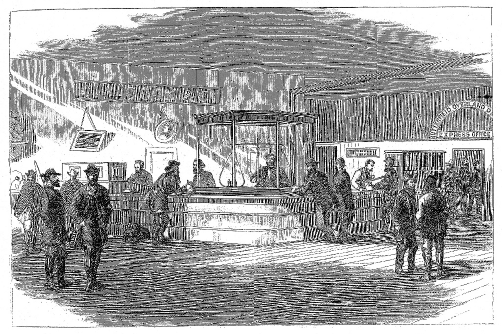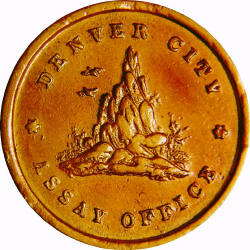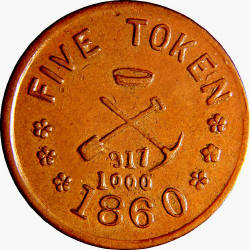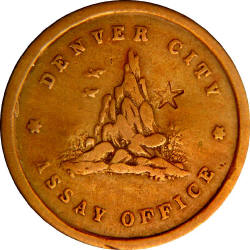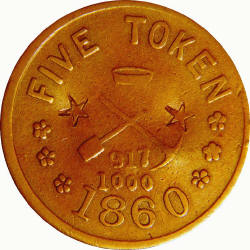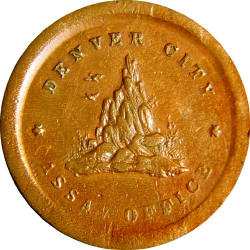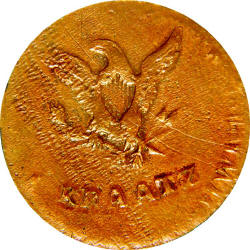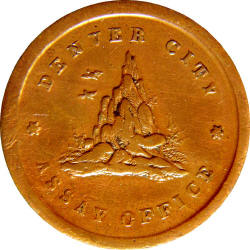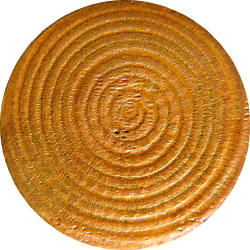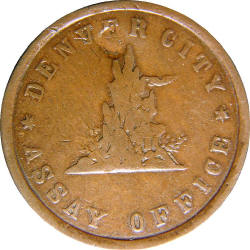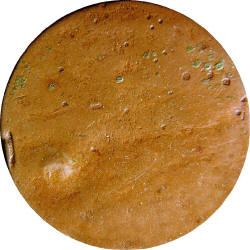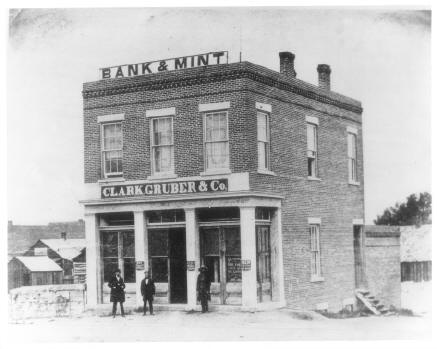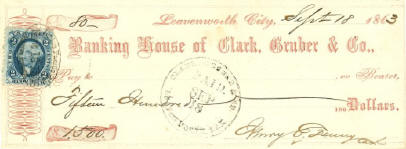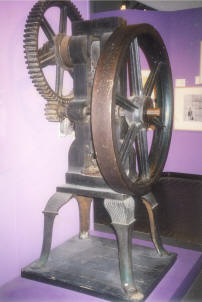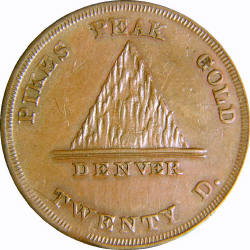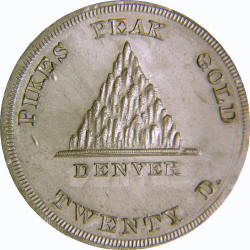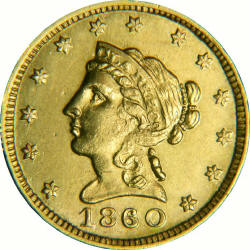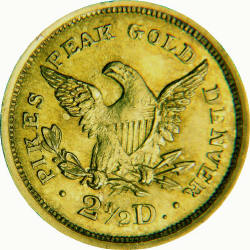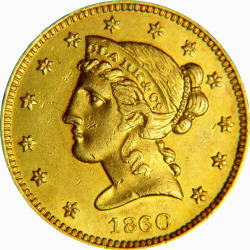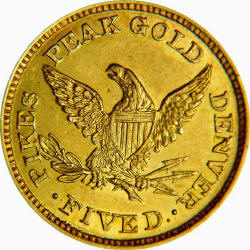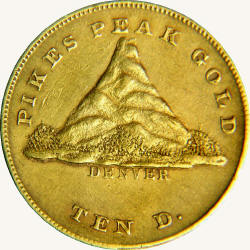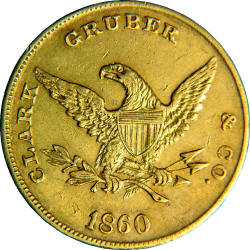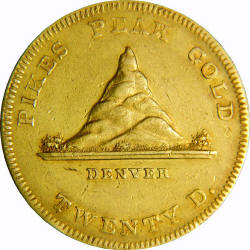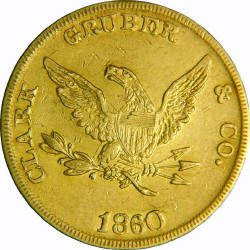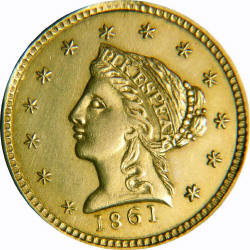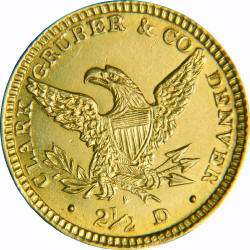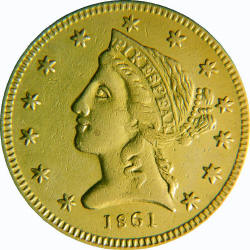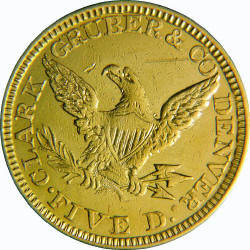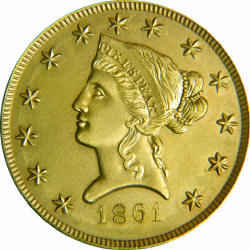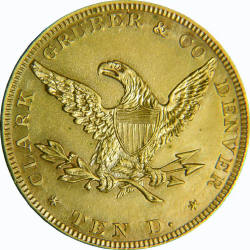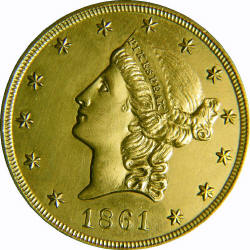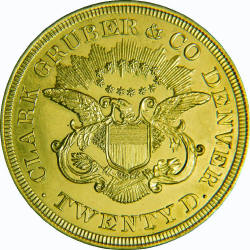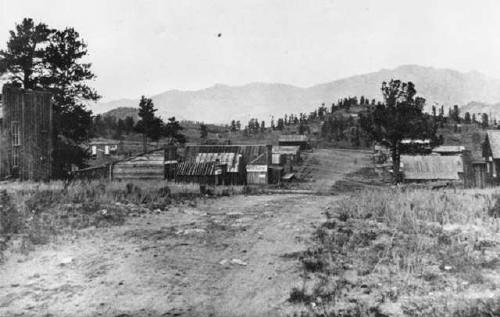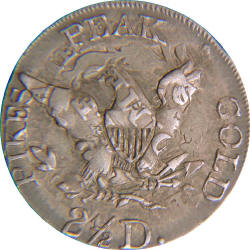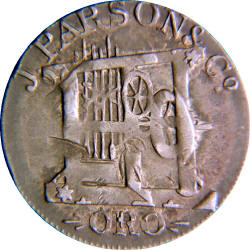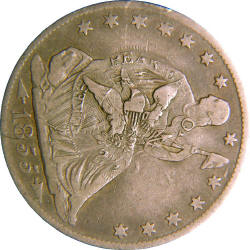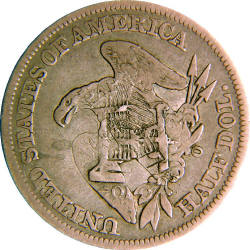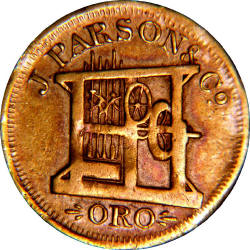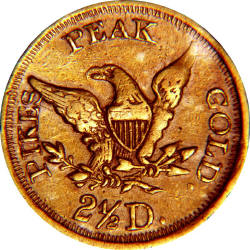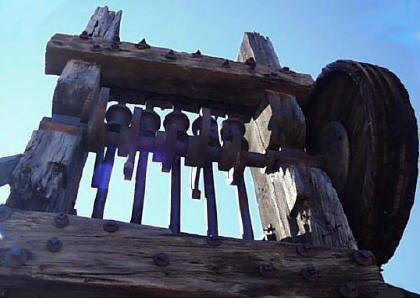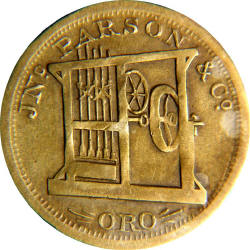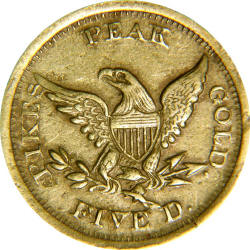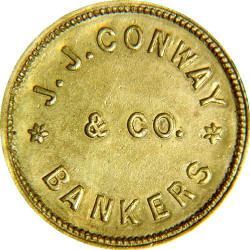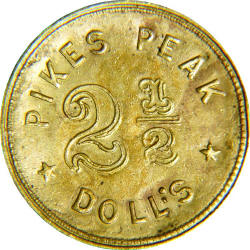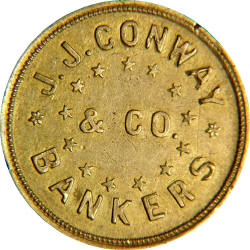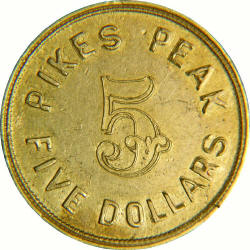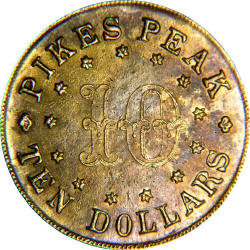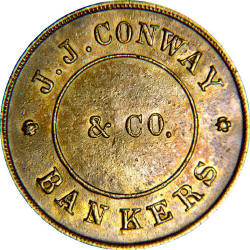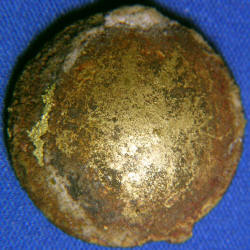|
Colorado
Territorial Gold |
|
|
|
|
(Click on coin images to see larger version)
Gold Coinage of Colorado during the Territorial Period
(credits)
Prior to 1864, it was legal for private individuals to mint gold coins of their own design. Since the value of an individual coin was based upon its intrinsic value of precious metal, coins of accurate fineness and weight manufactured by private firms were usually accepted at full value. In fact, several privately-issued gold coins were more readily accepted in certain regions than were Federal currency.
Most issuances of private gold coins were made in association with discoveries of major gold deposits. Beginning with the unexpected finding of gold in Georgia and North Carolina in 1828, scores of private minters produced millions of dollars worth of gold coins in denominations ranging from a quarter dollar through $50 gold slugs.
The last gold mining region in the United States where it was still legal to mint pioneer gold coins was the Territory of Colorado, during the period 1860-1862.
The Mayer collection is the finest, and most comprehensive group of these coins extant. This website illustrates examples of all of the known coins and patterns minted in Colorado during the territorial period and is organized by minter as follows:
Denver City Assay Office
Clark, Gruber and Company, Bank and Mint
Dr. John Parsons
J.J. Conway & Company, BankersThe first company to actually make working dies for the minting of gold coins in Colorado was the Denver City Assay Office. In April or May of 1860, this firm produced a few patterns $5.00 pieces as well as a $20 uniface pattern. All of the reported examples are struck in copper. No gold coins were minted by the firm.
W.J. Howard's Assay Office in Central City, ca. 1862
The dies for the Denver City Assay Office pattern gold tokens were engraved by Winslow J. Howard, a jeweler and watchmaker who arrived in Denver City early in 1860. Luckily, Howard was also a collector. He managed to collect an example of a pattern or coin from each of the four Colorado minters. It is believed that the actual striking of the coins was done by Cord Brothers Jewelers. It is probable that a $10 coin was also produced, but no examples are known to have survived. Beside the physical evidence of the few patterns that do survive, little else is known of the Denver City Assay Office.
Denver City Assay Office, $5.00 Pattern Token:
It is known that the dies for the Denver City Assay Office pattern gold 'tokens' were engraved by Winslow J. Howard, a jeweler and watchmaker who arrived in Denver City early in 1860. Howard was the first person to collect an example of a pattern or coin from each of the four Colorado minters.
The obverse of the Denver City Assay Office piece shows a mountain peak with trees at its base and two birds flying on the left. The words DENVER CITY ASSAY OFFICE, separated by two six-point stars, encircle the mountain.
There are several varieties of the reverse design. The most 'common' shows a crossed miners pick and shovel with a gold-mining pan above. Below is the fraction 917/1000, the fineness of Colorado gold. FIVE TOKEN CITY ASSAY OFFICE and the date 1860 complete the imagery.
Denver City Assay Office, $5.00 Pattern with Counterstamp:
Denver City Assay Office patterns are extremely rare. Six or seven $5.00 pieces and one or possibly two $20 patterns are all that still exist. It is thought that a $10 coin was also envisioned by the company founders, but no coin or pattern of this denomination has ever been located.
This unique $5.00 pattern (K-1a) was counterstamped by punching two, five-point stars into the tokens obverse. It is not known if this was done during the testing phase, or at a later date by persons unassociated with Denver City Assay Office.
This piece was unknown until 1954, almost one hundred years after its creation. It was discovered in the estate of a newspaper editor from Colorado Springs and ended up in the Henry Clifford Collection before being purchased by Mr. Mayer in 1981.
Denver City Assay Office, $5.00 Kratz Pattern Token:
The third variety of Denver City Assay Office $5.00 is the so-called 'Kraatz' reverse (K-2). This version has an American eagle very similar to that on the standard $5.00, with the word 'Kraatz' stamped below. Only two specimens are known. As with all Denver City Assay Office patterns, these pieces have a plain edge.
Despite extensive research it is not known who 'Kraatz' was, or if the name even refers to a person, rather than a place or company.
The workmanship on the eagle is much finer than that on the tokens mountain scene, suggesting a different person engraved the eagle. Because the tokens reference to mining and coinage have been replaced on the reverse with the Kraatz design, this piece could be considered a souvenir of early Denver rather than pattern coinage.
Denver City Assay Office, $5.00 Serpentine Pattern:
It is not know what the Denver City Assay Office coiners meant when they called their issue a 'five token' rather than a 'five dollar' coin. Possibly they wanted to avoid any entanglement over counterfeiting issues. But as long as they made their 'tokens' of full weight and value equal to a $5.00 gold coin, they had nothing to worry about under existing law.
The reverse on two or three specimens of the DCAO $5.00 (K-3) exhibits a whirl pattern. This 'serpentine' design is the result of tooling marks made on the back of several coins during the manufacturing process; it is not a die-struck design.
Winslow Howard reported in 1886 that the DCAO pieces were struck by Cord Brothers Jewelers, an early Denver firm. Unfortunately, the records of this company were also destroyed in the big fire of 1863.
Denver City Assay Office, $20.00 Pattern:
The rarest Denver City Assay Office piece is the $20 pattern (K-5), with Mr. Mayers being the only reported specimen. A second piece may exist, but the pattern is still so rare than prior to 2002, no color photograph of the piece existed; only a graining black-and-white reproduction from 1981.
The design on the $20 token is basically the same as that on the $5.00, except no birds grace the mountain scene. It is worth comparing the mountain (or portion of a mountain, according to some critics) on the $5 and that on this $20: they are different engravings, done at different times, and with subtle differences in placement of trees and other scenery.
The reverse of the $20 is blank. Apparently by the time a $20 reverse die was needed, the prospective business, like many other early territorial partnerships, had collapsed. All that is left of those dreams and ambitions are these five copper tokens from the Denver City Assay Office, 1860.
Clark Gruber & Company, Bank and Mint
By far the most successful private minter in the Pikes Peak region was the Leavenworth, Kansas, firm of Clark, Gruber & Co. The banking portion of the firm's operation opened for business in Denver City on July 10, 1860, making it one of the earliest banking houses in Colorado Territory.
The Clark, Gruber & Co. Bank and Mint was built at the corner of McGaa (now 16th) and G Street (now Market Street). The lots were purchased from friends of the Clark brothers in Leavenworth. The two-story multi-purpose building was constructed for $5,000.
An 1863 check from the Leavenworth office for $1,500. Revenue stamp tied by Union Pacific Ry cancel.A large portion of the firm's business was in raw gold: gold dust, gold nuggets, gold ore, even rough ingots. Within a few months, it became apparent that the expenses and danger of shipping the gold to the Mint in Philadelphia were too high. After determining that it was legal to issue coinage with a gold content worth more than its face value, the company obtained the equipment and dies needed to strike coins.
The highly regarded Leavenworth, Kansas, mercantile and banking firm of Clark, Gruber & Co. determined to establish a mint in Denver and issue gold coins valued at $2 1/2, $5, $10, and $20. With machinery and equipment bought in Philadelphia and New York, production began in July 1860.
In December 1859, Milton Clark traveled to Philadelphia and New York City to obtain dies and machinery to operate the new mint. The equipment, shown above, was shipped by rail to Leavenworth City, Kansas Territory; it then was carried in oxen-drawn wagon to Denver.
The Clark, Gruber Mint was soon processing over $2,000 in gold dust daily, which they paid for in their own coinage or drafts. The minting equipment operated day and night eventually producing over $3 million in coins which became the dominant form of regional currency.
The Clarks wanted the obverse of their $10 and $20 coins to have an image of Pikes Peak, with the reverse designed to look similar to regular U.S. coinage. A few supposed die trials exist that picture a very triangular mountain, including the examples above in copper and white metal.
For additional Clark, Gruber & Co. pattern coins, see the page here.
Clark, Gruber & Co., 1860 $2.50 Coin:
Each coin actually contained more gold than its United States government counterpart, with an intrinsic value slightly higher than its face value. This feature made the new coins immediately popular in a region where there was a shortage of coins but an abundance of gold dust and gold nuggets.
Clark, Gruber & Co. coins circulated widely throughout the western states for over 40 years. In 1906 a Clark, Gruber $20 piece was pulled from circulation and redeemed for its gold content. It is estimated that about one thousand coins still exist, in nine varieties. Mintage figures are unknown though it is reported that the mint produced $120,000 worth of coins during its first three months of operation.
Clark, Gruber & Co., 1860 $5.00 Coin:
Most Clark, Gruber 1860 quarter-eagle ($2.50) and half-eagle ($5.00) coins were weakly struck, meaning the center portion of the design did not fill the dies completely. This loss of detail is most noticeable in the hair around Miss Liberty's ear.
Clark, Gruber & Co., 1860 $10.00 Coin:
The most famous of all Clark, Gruber coins is the so-called "Mountain ten" of 1860 showing a highly stylized view of Pikes Peak. The mountain is still triangular in shape, but less geometric and more like a volcano than other designs.
The $10.00 eagle was the first denomination struck by the mint and was most people's introduction to "Pikes Peak gold." A newspaper reporter invited to the striking of the first coins observed that "the little engine that drives the machinery was fired up, belts adjusted ... and 'mint drops' of the value $10 began dropping into a tin pail with a most musical clink. About a thousand were turned out at the rate of 15 or 20 a minute." Today, fewer than 75 "mint drops" are known.
Clark, Gruber & Co., 1860 $20.00 Coin:
Even larger and more spectacular than the "Mountain Ten" was Clark, Gruber's "Mountain Twenty" coin. This large double eagle was slightly larger and heavier than the standard $20 U.S. gold coin of the era. There are fewer than twenty genuine specimens extant but counterfeits abound.
Clark, Gruber & Co., 1861 $2.50 Coin:
In 1861 Clark Gruber had new dies engraved for all four denominations. Gone was the design showing Pikes Peak as a volcano. It was replaced by an image of Miss Liberty, making the coinage almost identical in appearance to federal coinage. Only the words "Pikes Peak" on Liberty's headband showed the coin originated thousands of miles from the Philadelphia mint.
The 1861 $2.50 coin from Clark, Gruber mint is probably the most common of the series with approximately 200 specimens known.
Clark, Gruber & Co., 1861 $5.00 Coin:
Despite their similarly to federal issue $5.00 half-eagles, the Clark Gruber specimens are not quite as finely made as those struck at the Philadelphia mint. Notice how much larger the numeral "6" in the date is than the numeral "8."
The minters also changed the composition of metal slightly. The 1860 coins were virtually pure gold which caused them to wear easily. In 1861, Clark, Gruber alloyed the gold to harden the coins slightly. They kept the total amount of gold in the gold the same so that it actually contained $5.03 worth of gold.
Clark, Gruber & Co., 1861 $10.00 Coin:
One result of eliminating Pikes Peak from the obverse of the coin was that the date could now be moved to the front of the coin rather than on the reverse as in the 1860 series. Like other private minters, Clark Gruber measured their coinage against the standard of the federal mint, trying to make their product look as close as possible within legal constraints.
Clark, Gruber & Co., 1861 $20.00 Coin:
The 1861 Clark, Gruber $20.00 is considered to be the most finely engraved of all privately minted gold coins including those minted in California, Georgia and North Carolina as well. Other than the change of text on Liberty's headband, it is a near exact duplicate of James Longacre's impressive design for the United States double eagle, one of the most recognizable and beautiful coins of the nineteenth century.
It is not clear when Clark, Gruber ceased minting operations. There is some evidence the company made coins in 1862 using dies dated 1861.
Dr. John Parsons was a multi-talented medical doctor from Quincy, Illinois, who ventured west to Colorado Territory in 1859. Parsons, who also was a botanist and a hard-rock miner, had a strong background in metallurgy. In the summer of 1860, he moved to the Tarryall Mining district in South Park, where he assayed gold ore for placer miners.
Tarryall ca. 1860sIn 1861, after securing dies and equipment, Parsons returned to Tarryall, this time with a coin press mounted in the back of a wagon. In that summer, the towns of Hamilton and Tarryall were home to more than 6,000 miners. Parsons located his minting wagon at the mouth of Tarryall Creek, just west of the two towns.
It is reported that Parsons charge a fee as high as 20% to the miners wishing to convert their gold dust to coin. Thus a miner would receive a $5.00 coin in exchange for $6.25 of gold dust. Parsons left Tarryall before October 1861 and moved to Denver where he became active in several projects, notably a water-ditch company.
Dr. Parsons, 1850-O Half-Dime Overstrike:
It remains unknown where Dr. Parsons had his dies made or who made them. However, ten to twelve die trial pieces exist and were likely struck in the process of setting up the coining press. The piece above was struck on a United States 1850-O half-dime and as such is unique. This small silver coin was used because it is close in size to the gold $2.50 coin Parsons' wished to mint.
Dr. Parsons, 1855-O Half-Dollar Overstrike:
Only about eight of the Parsons $2.50 die trials are known. They are found on blank flans, half-dimes, dimes and the unique example shown above which was struck on a Liberty seated half-dollar.
Dr. Parsons, $2.50 Coin:
The obverse of the Parsons $2.50 and $5 gold piece shows a six-stamp, quartz reduction mill. Basically, this machine pulverized ore to aid in the extraction of the gold. The device portrayed is very similar to an actual example that was built in Buckskin Joe, a nearby town where Dr. Parsons owned a mining claim. That mill has been preserved and is shown below.
However, the die engraver make a mistake in the spelling of Dr. Parsons name by leaving off the terminal "s" on the coins. Below the mill is the Spanish word "oro," meaning "gold." The coin's reverse shows an American eagle and shield, similar to federal coinage of the time. The words "Pikes Peak Gold" surround the eagle with the denomination below. Fewer than ten examples survive of the Parsons $2.50 coin.
Dr. Parsons, $5.00 Coin:
According to contemporary reports, Parsons struck a "significant" number of $2.50 and $5.00 coins which circulated as far away as Denver. However, only four to six examples survive of the $5.00 denomination.
The obverse is on the $5.00 coin is similar to the $2.50 except that the first initial of Parsons name has been lengthened to "Jno." The reverse design is also similar but with the denomination changed to "Five D."
The final Colorado minter to be discussed is also the one that we know the least about. Newspaper reports state that Conway was a jeweler and watchmaker as well as a banker. The J.J. Conway mint struck $2.50, $5.00 and $10.00 gold coins in the summer of 1861 in Georgia Gulch near present-day Breckenridge. The dies were discovered in a Denver attic in 1924 and now reside in the collection of the Colorado Historical Society.
All three denominations of Conway's coins exhibit the simple obverse letter-punch design: "J.J. Conway & Co., Bankers" with two six point starts as spacers. The reverse designs incorporate a punch of denomination as well as "Pikes Peak " and text for the denomination. Although no date is given, it is clear that they were produced in July and August of 1861.
J.J. Conway & Co., Bankers, $2.50 Coin:
There are only seven Conway quarter-eagles reported.
J.J. Conway & Co., Bankers, $5.00 Coin:
Conway coins circulated as far south as Ft. Union, New Mexico, where five of the fifteen known pieces, including this coin, were recovered from a single site in the 1960s.
J.J. Conway & Co., Bankers, $10.00 Coin:
The $10.00 Conway gold coin holds the distinction of being the rarest of the Colorado gold coins with three examples known. Of these, two are now in the Smithsonian collection after having resided in the U.S. Mint cabinet for many years. This example is the only known in private hands.
This coin was found at Ft. Union, New Mexico in the 1960s along with several other Conway pieces. It was evidently left there by someone associated with the Colorado Volunteers who were assigned there in 1862 to stop a Confederate army from invading Colorado. The matter was resolved with the Federal victory at Glorieta Pass when the Confederates were forced to retreat to Texas.
J.J. Conway & Co., Bankers, Ft. Union Gold Button
The melted gold button, or cupel, was reportedly found in the burned-out ruins of the sutler's shop at Fort Union. It weighs 620 grains, meaning that it contained about 1.4 ounces of gold. A possible combination of Conway coins that melted would equal that weight would be two $2.50,two $5.00 and one $10.00.
Website: Richard Frajola
Text: Dr. Lawrence Lee and Richard Frajola
Photography: David McCarthy, Dr. Dan Kagin
This exhibit of Colorado Territorial coins is currently on display at the Colorado Historical Society through August 2009.
Richard Frajola (September 2008)



